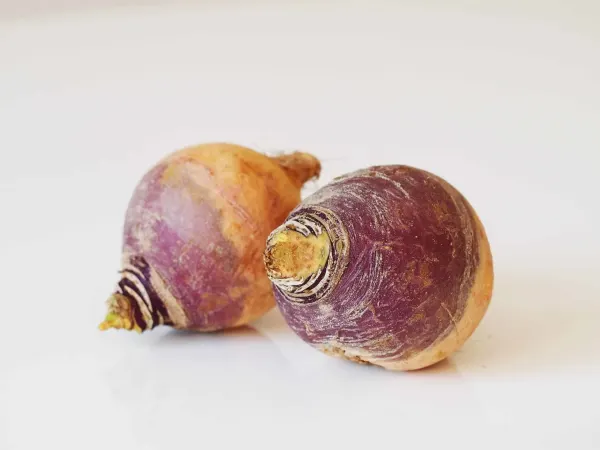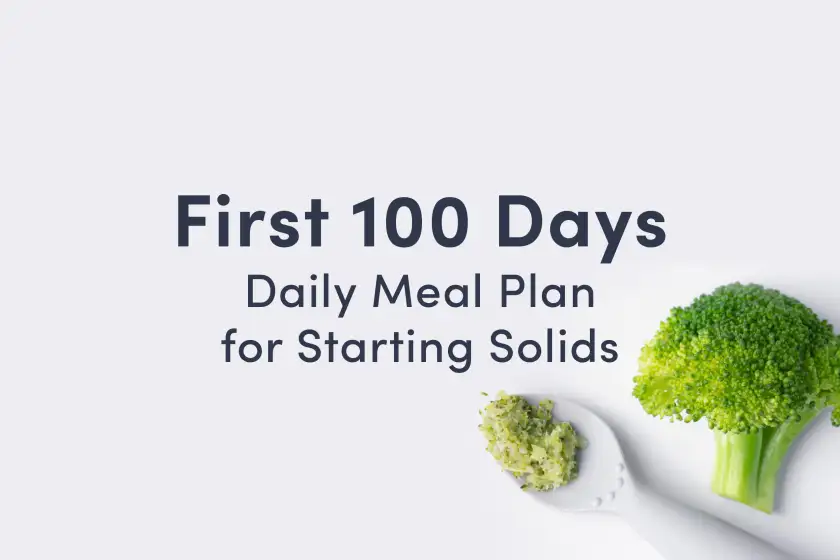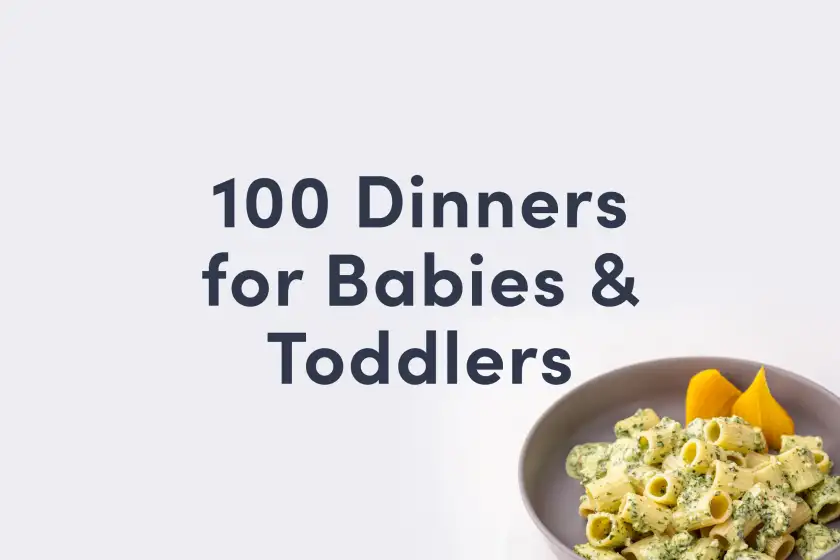Rutabaga (Swede)
Vegetable
Age Suggestion
6 months
Iron-Rich
No
Common Allergen
No

When can babies have rutabaga?
Rutabaga, when cooked until soft, may be introduced as soon as baby is ready to start solids, which is generally around 6 months of age.
Where does rutabaga come from?
Centuries ago, wild cabbage crossed with turnip in the northern fields of Asia and Europe, creating the cruciferous vegetable known as rutabaga—a loanword meaning “baggy root” in an old Swedish dialect. Trade brought rutabaga to the United Kingdom, where the vegetable was called Swedish turnip or simply “swede” as a nod to its assumed origin. Today, rutabaga is known as bryukva, gulrófa, kålrot, lanttu, and neep across the northern regions of Europe and Russia. Grocers tend to sell rutabaga that are about the size of a fist, though the root can keep growing when left to sweeten in the soil with the winter frost. Some grow so big that they are carved into lanterns at Halloween and Sauin (Samhain), the Celtic festival marking the transition from harvest-time to winter.
Videos
Is rutabaga healthy for babies?
Yes. Rutabaga is a good source of folate, B vitamins, notably B6 for cell energy, and potassium, contributing to baby’s nerve, muscle, and heart health. Like many root vegetables, it offers a good amount of fiber to support digestive health. It also contains alpha linoleic acid—a plant-based omega 3 fatty acid—to support a healthy brain and development. Rutabaga and its edible leaves contain glucosinolates, a unique group of compounds with anti-cancer properties that are also responsible for rutabaga’s touch of bitterness. The root contains vitamin C as well, which helps support baby’s immune system and aids in iron absorption from plant-based foods. Lastly, rutabaga has a touch of calcium for strong bones.
★Tip: Once harvested, rutabagas are often coated with inedible paraffin wax to help preserve them for long-term storage. Remove the wax before cooking by scrubbing or peeling the skin.
Is rutabaga a common choking hazard for babies?
Yes. For children under the age of five, raw, hard vegetables and fruits are high on the list of choking hazards, as they are tough to chew. To minimize the risk, peel and cook rutabaga until soft. As always, make sure you create a safe eating environment and stay within an arm’s reach of baby during meals. For more information on choking, visit our sections on gagging and choking and familiarize yourself with the list of common choking hazards.
Is rutabaga a common allergen?
No. Allergies to rutabaga are not common, though in theory, an individual can be allergic to any food. Individuals who are allergic or sensitive to other members of the cruciferous family, such as mustard greens and broccoli, could in theory be sensitive to rutabaga.
As with all new foods, introduce rutabaga by serving a small quantity and observe as baby eats. If there is no adverse reaction, gradually increase the quantity over future servings.
Recommended Guide: Introducing Allergens
Can rutabaga help baby poop?
Yes. Rutabaga offers good amounts of fiber, particularly insoluble fibers (which help bulk up bowel movements), as well as glucosinolates and phenols. Together, these components contribute to overall digestive health and bowel regularity. Note that pooping patterns can vary significantly from child to child. Be sure to talk to your pediatric healthcare provider if you have concerns about baby’s pooping and digestive function.
What are recipe ideas for rutabaga?
Rutabaga works well as a potato substitute in most recipes. As in dishes throughout Northern Europe and Russia, try pairing rutabaga with lamb, pork, or venison, as well as rich fats like butter, ghee, or olive oil. For a lighter meal, try raw, grated rutabaga in slaws with the bright flavors from apple and the rich nuttiness of hazelnut to balance the root’s slightly bitter flavor, as in the dish called kålrabi salat from Denmark and Norway. You can also serve rutabaga alongside sources of plant-based iron, like beans, dark leafy greens, lentils, nuts, quinoa, and seeds.
How do you prepare rutabaga for babies with baby-led weaning?
Every baby develops on their own timeline, and the suggestions on how to cut or prepare particular foods are generalizations for a broad audience.
6 to 9 months:
Offer peeled, cooked rutabaga wedges that baby can grab and munch on. Alternatively, serve mashed rutabaga, either on its own or as a binder for cooked grains, lentils, or seeds. If you’d like to serve rutabaga leaves, cook the greens from young plants (the leaves become bitter and tough as they age), then finely chop and stir into the mashed root, egg dishes, meatballs, or fritters. If you would like to offer a tough cooked leaf to baby, they can use this as a teether to help build a map of the mouth, but don’t expect anything to be chewed or swallowed.
9 to 12 months old:
At this age, babies develop the pincer grasp (where the thumb and forefinger meet), which enables them to pick up smaller pieces of food. When you see signs of this development, try moving down in size and offering bite-sized pieces of cooked rutabaga. Try not to fret when you see baby trying to shovel food into their mouth: it is normal at this age and a good learning experience for the child as they understand the boundaries of their mouth. If you prefer, you can continue to offer cooked, mashed rutabaga.
12 to 24 months:
Once a toddler has developed the ability to bite and tear with their teeth, raw rutabaga can be grated or cut into paper-thin slices, which you can serve on their own, dressed with a simple sauce, or mixed with other foods. You can also use cooked rutabaga (mashed or grated) in bean patties, dumplings, fritters, meatballs, and pancakes.
Post our Nutrient Cheat Sheet in the kitchen for a quick reference to the nutrients that babies need most.
Written by
Expert Tips Delivered to Your Inbox
Sign up for weekly tips, recipes and more!
The content offered on SolidStarts.com is for informational purposes only. Solidstarts is not engaged in rendering professional advice, whether medical or otherwise, to individual users or their children or families. No content on this site, regardless of date, should ever be used as a substitute for direct medical advice from your doctor or your medical or health professional, nutritionist, or expert in pediatric feeding and eating. By accessing the content on SolidStarts.com, you acknowledge and agree that you are accepting the responsibility for your child’s health and well-being. In return for providing you with an array of content “baby-led weaning” information, you waive any claims that you or your child may have as a result of utilizing the content on SolidStarts.com.











